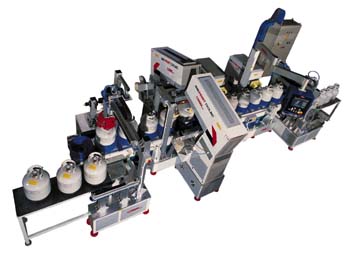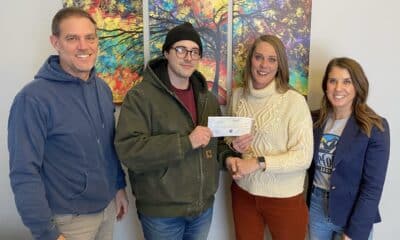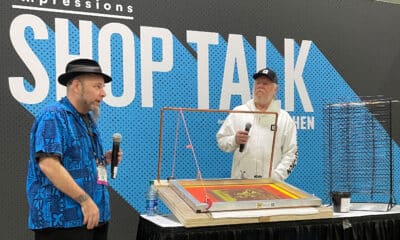Articles
Published
20 years agoon

Pad Print Machinery of Vermont
When faced with a large-format job, most printers will choose among a few well-known and popular methods to complete the task. Screen printing and digital imaging usually come to mind first. Either method can be suitable if the substrate is flat and the images are composed of large areas of color. But what happens when printers are confronted with large-format applications that involve irregular or three-dimensional surfaces? Most will look for a way to decorate the part while it’s still flat and later change it to the desired shape–by thermoforming or using another process–just to avoid printing a compound surface. This approach is both expensive and unnecessary because a more convenient solution exists: pad-printing technology.
Large-format pad printing is an effective means of printing on substrates that are rough, undulating, or three dimensional in design (Figure 1). For this discussion, we’ll identify large-format jobs as those that involve items such as control panels for large appliances (Figure 2), front bezels on televisions, computer keyboards, and similar parts.
When you consider using large-format pad printing as an alternative to more typical imaging methods, base your decision on your answers to the following questions: How large is the total image area? Can I break the graphics down into smaller, more manageable, images that fit within the limits of my pad-printing equipment? How many colors are involved? How much area does each color cover? Am I dealing with large, solid, areas of ink or realistic coverage that is broken up somewhat? How curved or uneven are the print surfaces?
In this article, we’ll consider these questions more closely and examine the advantages of using pad-printing technology for large-format work. We’ll also review some of the challenges inherent to large-format pad printing and how they can be overcome.
Pad-printing technology
Several advances have made pad printing viable for large-format work. Pad-printing inks have evolved from primitive, hand-milled, natural materials to complex, micro-milled, highly opaque inks containing man-made pigments. The inks are now formulated with better flow-control agents that allow us to print smoother and larger surface areas. Pad materials also have been enhanced from gelatin types to high-tech, fast-curing, durable silicone varieties that allow us to create pads in any shape and durometer we need in order to exactly fit our requirements. And large, hollow pads enable us to pick up and print much larger images than we could as few as 15 years ago.
Interestingly, the evolution from open-inkwell pad presses to sealed-cup systems actually moved us slightly backwards in terms of the total image area available on a single cliche. The problem is that ink cups generally are limited to a diameter of only 10 in. and, in some cases, as small as 8 in. The exception to the rule is the slide cup that utilizes a long cliche and allows the image length to far exceed the cup diameter. This system facilitates successful printing of images as long as 3 or even 4 ft using a single cliche. Still, the old open-well systems gave the user larger print areas on a single cliche than what is typically possible with most newer closed-cup systems.
Pad-printing presses have moved from manual to motorized to pneumatic to hydraulic to servo-controlled drive systems. It’s these servo drives that make the machines so well suited for printing large-format parts. The integration of computer numeric control (CNC) servo-motor technology was the single most important factor that made large-format pad printing possible. Servo-driven CNC pad presses are able to select a suitable pad, go to the cliche area, and precisely pick up one of many images from a high-tech, polymer-resin plate. The image could comprise very opaque, solvent-based ink or a UV-curable formulation, depending upon the manufacturer’s choice or the client’s requirements.
This new technology also enables us to use a more conventional press format–a press that is designed with a row of pads, a conveyor system in front, and cliches behind. With independent pads, such systems can operate without limiting where we pick up the images, where we print them, or in what sequence we print them. The servo drive gives us much more flexibility in positioning, and when coupled with an independent pad system–now offered by most pad-press manufacturers–allows the operator to select one image from a single cliche that may have multiple images etched into its surface and then print that image wherever it needs to be printed. The positioning accuracy afforded by servo-driven CNC pad presses is one of their greatest strengths. As an example, consider that today’s machines can reproduce a 15-in. line by printing two 7.5-in. lines side by side in perfect alignment.
Borrowing technology from the machining industry allows us to print in situations where a surface needs to be decorated with multiple images of different shapes and sizes. In these cases, one pad shape often will not work, so just as CNC machining equipment changes cutting tools or drills mid-job, the pad-printing presses simply change from one pad shape to another. This practice essentially combines several single-color jobs into a single multicolor run. It also helps in situations that require printing the same image or a group of images on more than one surface.
A shuttle-type conveyor coupled to a servo drive is a perfect combination. It adds the extra axis we need to print large-format components with multiple images over a large surface area while using ink cups that may be as small as 5 in. in diameter. The servo drive on the printer gives us the positioning capability we need on the Y axis, and the servo shuttle provides the positional control we need on the X axis (Figure 3).
The latest pad presses also save space and time because work in process no longer exists (with the exception of unprinted parts). If a large-format part were printed on smaller machines, it would have to pass through a series of presses, and each press would be responsible for decorating a part of the whole. Using several smaller presses to print large parts adds labor and reduces the space available for moving and storing parts during print operations.
Let’s not forget the PC or program-mable logic controller (PLC)–the conductor of this whole orchestra. We now have machines running on microprocessor-driven control systems that integrate all of the automation (Figure 4). Some pad presses can now memorize production routines and recall all the critical settings so that we can quickly set up recurring jobs. We also can network the computers so management can see at any moment which machines are at work.
Benefits and challenges
Pad printing–even in smaller formats–offers several benefits to shops that take on wide varieties of jobs or applications with unique decoration requirements. For example, uneven substrate surfaces present little or no problem to the malleable pad materials. Wet-on-wet printing is not an issue. The cost of producing the cliches in house is very reasonable and requires only a small investment in equipment. Pad printing is relatively simple to learn and implement, and even unskilled operators can set up presses quickly. Finally, print quality is superb, and four-color-process printing has become commonplace with pad-printing equipment. Of course, no printing technology is perfect. There are limits to what the technology can do, particularly with large-format applications.
Large ink-coverage areas Large areas of ink coverage are difficult, and sometimes impossible, to deal with. The main problem with large images is that the doctor blade (or doctoring ring on closed-cup systems) can dip into the etched area and draw out ink before the pad picks up the image–a condition known as scooping. The best solution is to produce such large image areas as halftones on the cliche. To improve coverage, the image can be printed in multiple hits. This option works, but be aware that it decreases productivity, particularly on single-color pad presses, which will require multiple cycles in order to complete the print.
A single-color job that requires two or more hits to provide a complete image moves along much faster on a press that supports two or more colors. And if newer multicolor, servo-driven CNC equipment is used, the job may be completed in a single hit with a large-format pad or in multiple hits that occur in sequence during a single cycle of the machine.
The main reason that large areas of solid ink do not print very evenly with pad printing has to do with the way the pad rolls into the etched areas of the cliche during image pickup. If we use a pad that is correctly designed, it will generally have the wedge-shaped profile of a roof top or mountain. The point of the pad applies more pressure on the ink surface than does the outer perimeter and will usually displace the ink more than the outer area. This creates a printed ink layer that is uneven and, in many cases, will look like the surface of a pond with ripples emanating from the center.
The number of colors in an image and the total image area are important factors because the image size limitation of some multicolor pad presses may be as small as 8 in. in diameter per color. If you’re not that familiar with large-format pad printing–or multicolor pad printing–be sure to discuss your applications with your press supplier. You may be surprised to discover that the equipment is well suited to the job, or learn that pad printing is inappropriate before you invest in equipment. Always be sure to seek out second or third opinions from other sources.
Image orientation The orientation of images on a cliche also plays an important role in whether or not scooping will occur. For example, if an image of a 5 x 1-in. rectangle were positioned with the narrow edge perpendicular to the cup motion, scooping would be minimized. But if the cup had to cross the image at its widest dimension, scooping could occur and cause faded areas in the print. It would seem that rotating the image is a simple solution, but then we need to rotate the substrate as well in order to position the image correctly. Machines that support pad rotation from the printhead alleviate this problem. Such systems make image orientation on the cliche irrelevant because the operator can program the image-delivery position in any way he or she sees fit. No time is lost in production because the rotation of the head occurs while the pad is traveling from the cliche to the substrate. The rotating-head feature also is beneficial for preserving registration on prints involving multiple colors.
Large image areas In the past, the cliche and inking system of a pad-printing press defined the maximum image size the machine could print. But the precision of modern servo-driven equipment and the sophistication of the logic systems that control them allows images to be broken into pieces that can be printed in separate hits. The greater the number printheads on the press, the more efficiently the print can be completed.
If the image area is extremely large, an ideal solution is to use a pad press that has the capability to print the part corner to corner. Some newer pad-printing presses have this ability, so be sure to ask the manufacturer before committing to a piece of equipment that may not be able to meet all of your requirements.
Other challenges include jobs in which overall image size exceeds the traversing range of the conveyor or shuttle system that holds the part being printed. In these circumstances, the only option may be to reset the machine and print the part in two separate passes through the machine. While this method is clearly not the most economical way to print, it can really save the day.
Add value and versatility with pad printing
The flexibility that pad printing offers in decorating irregular substrates not only makes the process an excellent complement to screen printing and digital imaging, but also makes the technology an effective first choice for some large-format jobs. Advances in pad presses allow us to print more accurately and efficiently on a wider range of products than with any other printing method, and as the technology continues to evolve, we can only guess where it will take us next.
About the author
Julian Joffe is president and CEO of Pad Print Machinery of Vermont (www.pad printmachinery.com), East Dorset, VT, a manufacturer and supplier of pad-printing equipment, inks, and related materials. Joffe’s 28 years in the pad-printing industry include experience in equipment engineering and machine design. He also is also credited for several innovations related to imaging on medical devices.

Subscribe

Magazine
Get the most important news
and business ideas from Screenprinting Magazine.
Most Popular
-

 Columns1 month ago
Columns1 month ago8 Marketing Mistakes Not to Make When Promoting Your Screen Printing Services Online
-

 Press Releases1 month ago
Press Releases1 month agoSports Inspired Clothing Market: The Influence of Sports on Fashion Forward Looks
-

 Editor's Note1 month ago
Editor's Note1 month agoLivin’ the High Life
-

 Marshall Atkinson1 month ago
Marshall Atkinson1 month agoHow to Create a Winning Culture in Your Screen-Printing Business
-

 Press Releases4 weeks ago
Press Releases4 weeks agoHope Harbor to Receive Donation from BlueCotton’s 2024 Mary Ruth King Award Recipient
-

 Case Studies1 month ago
Case Studies1 month agoScreen Printing for Texture and Depth
-

 News & Trends2 months ago
News & Trends2 months agoWhat Are ZALPHAS and How Can You Serve Them in Your Print Business?
-

 Headlines1 month ago
Headlines1 month agoLive Poster Printing Raises $30K for Charity






